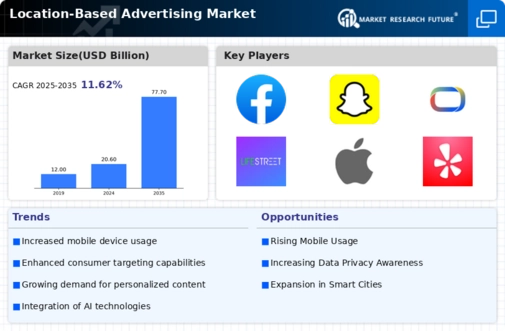Rise of Mobile Device Usage
The proliferation of mobile devices has catalyzed the Location-Based Advertising Market. As of 2025, approximately 80% of the global population owns a smartphone, which serves as a primary tool for accessing location-based services. This trend indicates a shift in consumer behavior, where users increasingly rely on their devices for navigation, shopping, and social interactions. Consequently, advertisers are leveraging this trend to deliver targeted ads based on real-time location data. The ability to reach consumers at the right place and time enhances engagement and conversion rates, making location-based advertising a pivotal strategy for businesses aiming to optimize their marketing efforts. As mobile device usage continues to rise, the Location-Based Advertising Market is poised for substantial growth, driven by the demand for personalized and contextually relevant advertising.
Growing Demand for Real-Time Marketing
The increasing demand for real-time marketing is reshaping the Location-Based Advertising Market. Consumers today expect immediate and relevant interactions with brands, particularly when they are in proximity to a store or service. This expectation drives businesses to adopt location-based strategies that deliver timely offers and promotions. According to recent data, nearly 70% of consumers are more likely to engage with brands that provide real-time, location-specific content. This trend underscores the importance of immediacy in advertising, as businesses strive to capture consumer attention at critical moments. As the appetite for real-time marketing continues to grow, the Location-Based Advertising Market is expected to thrive, with companies investing in technologies that facilitate instant communication and engagement.
Increased Focus on Customer Experience
The emphasis on enhancing customer experience is a key driver in the Location-Based Advertising Market. Businesses recognize that delivering personalized and relevant content can significantly improve customer satisfaction and loyalty. By utilizing location data, companies can tailor their advertising efforts to meet the specific needs and preferences of consumers in real-time. This approach not only fosters a more engaging shopping experience but also encourages repeat business. As of 2025, studies indicate that brands that prioritize customer experience see a 60% increase in customer retention rates. Consequently, the Location-Based Advertising Market is likely to see continued investment in strategies that enhance customer interactions, ultimately leading to improved business outcomes.
Regulatory Developments in Data Privacy
Regulatory developments surrounding data privacy are shaping the landscape of the Location-Based Advertising Market. With increasing scrutiny on how consumer data is collected and utilized, businesses must navigate a complex regulatory environment. As of 2025, regulations such as the General Data Protection Regulation (GDPR) and various local laws mandate transparency and consent in data usage. This shift compels advertisers to adopt more ethical practices in their location-based strategies, ensuring compliance while still delivering effective advertising. While these regulations may pose challenges, they also present opportunities for businesses to build trust with consumers. By prioritizing data privacy, companies can enhance their brand reputation and foster long-term relationships with customers, thereby positively impacting the Location-Based Advertising Market.
Advancements in Geolocation Technologies
Technological advancements in geolocation capabilities are significantly influencing the Location-Based Advertising Market. Innovations such as GPS, Wi-Fi triangulation, and Bluetooth beacons have improved the accuracy and reliability of location data. As of 2025, the accuracy of location tracking has reached within a few meters, allowing advertisers to target consumers with unprecedented precision. This level of accuracy enables businesses to create hyper-localized marketing campaigns that resonate with consumers in specific geographic areas. Furthermore, the integration of augmented reality with geolocation technologies offers immersive advertising experiences, enhancing consumer engagement. As these technologies evolve, the Location-Based Advertising Market is likely to expand, providing advertisers with new avenues to connect with their audience effectively.


















Leave a Comment